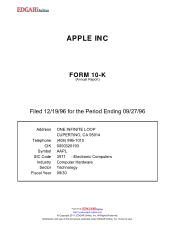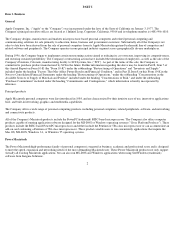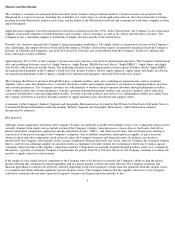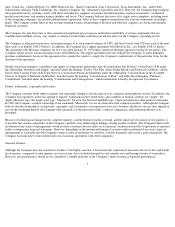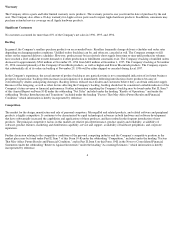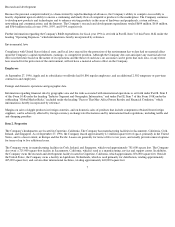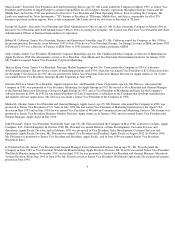Apple 1996 Annual Report Download - page 6
Download and view the complete annual report
Please find page 6 of the 1996 Apple annual report below. You can navigate through the pages in the report by either clicking on the pages listed below, or by using the keyword search tool below to find specific information within the annual report.Markets and Distribution
The Company's customers are primarily in the education, home, business and government markets. Certain customers are attracted to the
Macintosh for a variety of reasons, including the availability of a wide variety of certain application software, the reduced amount of training
resulting from the Macintosh's intuitive ease of use, and the ability of the Macintosh to network and communicate with other computer systems
and environments.
Apple personal computers were first introduced to education customers in the late 1970s. In the United States, the Company is one of the major
suppliers of personal computers for both elementary and secondary school customers, as well as for college and university customers. The
Company is also a substantial supplier to institutions of higher education outside of the United States.
Presently, the Americas represent the Company's largest geographic marketplace. The Apple Americas organization focuses on the Company's
sales, marketing, and support efforts in North and South America. Products sold in these regions are primarily manufactured in the Company's
facilities in California and Singapore, and in the SCI facility in Colorado, and are distributed from the Company's facility in California and
from a third-party facility in Illinois.
Approximately 46% to 52% of the Company's revenues in recent years has come from its international operations. The Company's international
sales and marketing divisions consist of: Apple Americas; Apple Europe, Middle East and Africa ("Apple EMEA"); Apple Japan; and Apple
Asia Pacific (which does not include Japan). The marketing divisions focus on opportunities in their regions. Products sold by Apple EMEA
are manufactured primarily in the Company's facility in Cork, Ireland. Products sold by Apple Americas, Apple Japan, and Apple Asia Pacific
are manufactured primarily in the Company's facilities in California and Singapore, and in the SCI facility in Colorado.
The Company distributes its products through third-party computer resellers, and is also continuing its expansion into various consumer
channels, such as mass merchandise stores, consumer electronics outlets and computer superstores, in response to changing industry practices
and customer preferences. The Company's products are sold primarily to business and government customers through independent resellers,
value- added resellers and systems integrators; to home customers through independent resellers and consumer channels; and to education
customers through direct sales and independent resellers. In order to provide products and service to its independent resellers on a timely basis,
the Company distributes its products through a number of Apple and third- party distribution and support centers.
A summary of the Company's Industry Segment and Geographic Information may be found in Part II, Item 8 of this Form 10-K under Notes to
Consolidated Financial Statements under the heading "Industry Segment and Geographic Information," which information is hereby
incorporated by reference.
Raw materials
Although certain components essential to the Company's business are generally available from multiple sources, key components and processes
currently obtained from single sources include certain of the Company's displays, microprocessors, mouse devices, keyboards, disk drives,
printers and printer components, application-specific integrated circuits ("ASICs") and other custom chips, and certain processes relating to
construction of the plastic housing for the Company's computers. Any availability limitations, interruption in supplies, or price increases
relative to these and other components could adversely affect the Company's business and financial results. In addition, new products
introduced by the Company often initially utilize custom components obtained from only one source, until the Company has evaluated whether
there is a need for an additional supplier. In situations where a component or product utilizes new technologies, there may be initial capacity
constraints until such time as the suppliers' yields have matured. Components are normally acquired through purchase orders, as is common in
the industry, typically covering the Company's requirements for periods from 90 to 180 days. However, the Company continues to evaluate the
need for a supply contract in each situation.
If the supply of a key single-sourced component to the Company were to be delayed or curtailed, the Company's ability to ship the related
product utilizing that component in desired quantities and in a timely manner could be adversely affected. The Company's business and
financial performance could also be adversely affected, depending on the time required to obtain sufficient quantities from the original source,
or to identify and obtain sufficient quantities from an alternate source. The Company believes that the suppliers whose loss to the Company
could have a material adverse effect upon the Company's business and financial position include, at this
4

